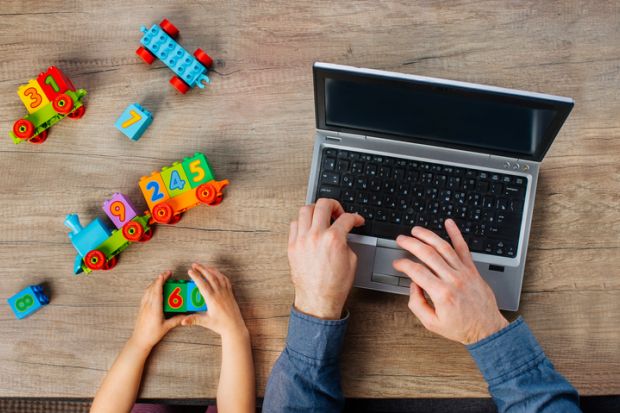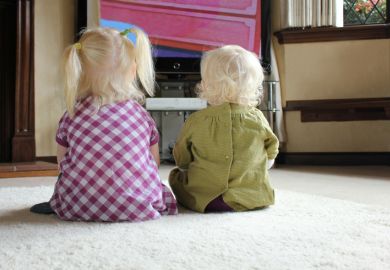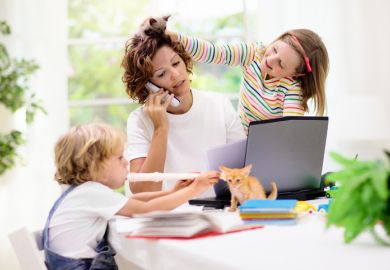After muddling through the rapid move to remote teaching and learning in lockdown 1.0 (with a two-year-old and a six-year-old in tow) and navigating the more relaxed restrictions for higher education in lockdown 2.0, we didn’t anticipate being here once more, this time in lockdown 3.0 (tier 5) almost a year later and looking ahead to our teaching-heavy semester again.
In our experience, and through talking to colleagues and friends across the sector, those working in higher education are feeling ever more drained and exhausted this time around. We care deeply for our colleagues, our students and the quality of our teaching and research, but with a year of immense uncertainty for higher education provision and the need to remain highly adaptable at the drop of a hat, this way of working is taking its toll on both academics and professional staff, which inevitably has repercussions on home life.
Like many other academic families with young children, we were looking forward to the routine and security of dropping off our children at nursery and school this past Monday, which would give us the headspace to get back into our academic roles. However, the rapid about-turn by the government and the announcement of the new lockdown that very Monday evening (the prime minister gave the nation four hours!) meant that we were faced with uncertainty over homeschooling and our teaching provision.
This is not normal: Advice for stressed academics
However, lockdown 3.0 is very different from the previous incarnations. In lockdown 2.0, universities followed the local tier system, and most were able to carry on with blended learning and research with Covid measures in place, such as enhanced risk assessments and the use of PPE. Lockdown 1.0 was, of course, an entirely different beast, with the move to online-only learning almost overnight and the advice to stay home and work there, too (where possible).
It was a steep learning curve – and one that had to be negotiated while incorporating homeschooling and childcare duties. At the time, there was much reactive improvisation over teaching provision because of the speed at which the move to remote learning was announced. Now, however, we are more used to working this way, and there has been a proliferation of guidance on remote teaching and learning practice through blogs, books, journal articles, webinars and platforms that have arisen from the higher education sector since the first lockdown.
This sharing of information and support for one another has been invaluable in dealing with subsequent lockdowns. The realisation that working parents were negatively impacted during the first lockdown has also meant that academic parents now have the option of using a childcare bubble and being covered as essential workers (under education). Hence, we feel that homeschooling is much less of an issue this time around, as children can attend nurseries and primary schools when we are teaching.
In this current lockdown, and given the time the sector has had to digest new ways of working, there is an expectation that teaching design and delivery is approached strategically and that high-quality teaching standards are preserved. Reflecting on our experiences during the previous lockdowns, we found two approaches that have proven useful to future-proofing courses in times of uncertainty and change.
Why and how to gather ongoing student feedback right from the start
The first is through co-productive research and teaching between students and course instructors. By placing students as co-producers in a longitudinal, multidimensional research project that is iterative, it is entirely possible to continue real-world and meaningful assessments against a wide range of possible delivery mechanisms. This was realised in lockdown 1.0, when it was proven possible to move a field trip (Theresa’s) online within a week, as it formed part of a larger research project within an urban woodland and with various cohorts of students adding to it each year (via drone footage, photos, vegetation surveys, soil and water data, mapping of invasive species). This meant that there was pre-existing data for students to use to generate reports, plus the option of producing a virtual field trip with pre-existing photos and videos.
The second approach to future-proofing courses that we found useful was through discipline-based educational research. This approach has seen students making a real difference to society by educating younger generations through the creation of educational tools designed to promote pro-environmental behaviours in school children. Aside from the benefits of this approach for academics, HE students, school pupils and the wider community, this type of approach can also be delivered in a variety of mechanisms. Going forward, we are hoping to continue working alongside students in co-produced educational research, but this time to investigate the use of digital games in promoting pro-environmental behaviour.
In this time of great uncertainty, there’s perhaps one thing we are sure of: it’s going to be interesting trying to incorporate discipline-based education with all the professional and family life logistics of coping with university teaching and research as the Covid pandemic continues.
Theresa Mercer and Andrew Kythreotis are senior lecturers in the School of Geography at the University of Lincoln.
Register to continue
Why register?
- Registration is free and only takes a moment
- Once registered, you can read 3 articles a month
- Sign up for our newsletter
Subscribe
Or subscribe for unlimited access to:
- Unlimited access to news, views, insights & reviews
- Digital editions
- Digital access to THE’s university and college rankings analysis
Already registered or a current subscriber?




